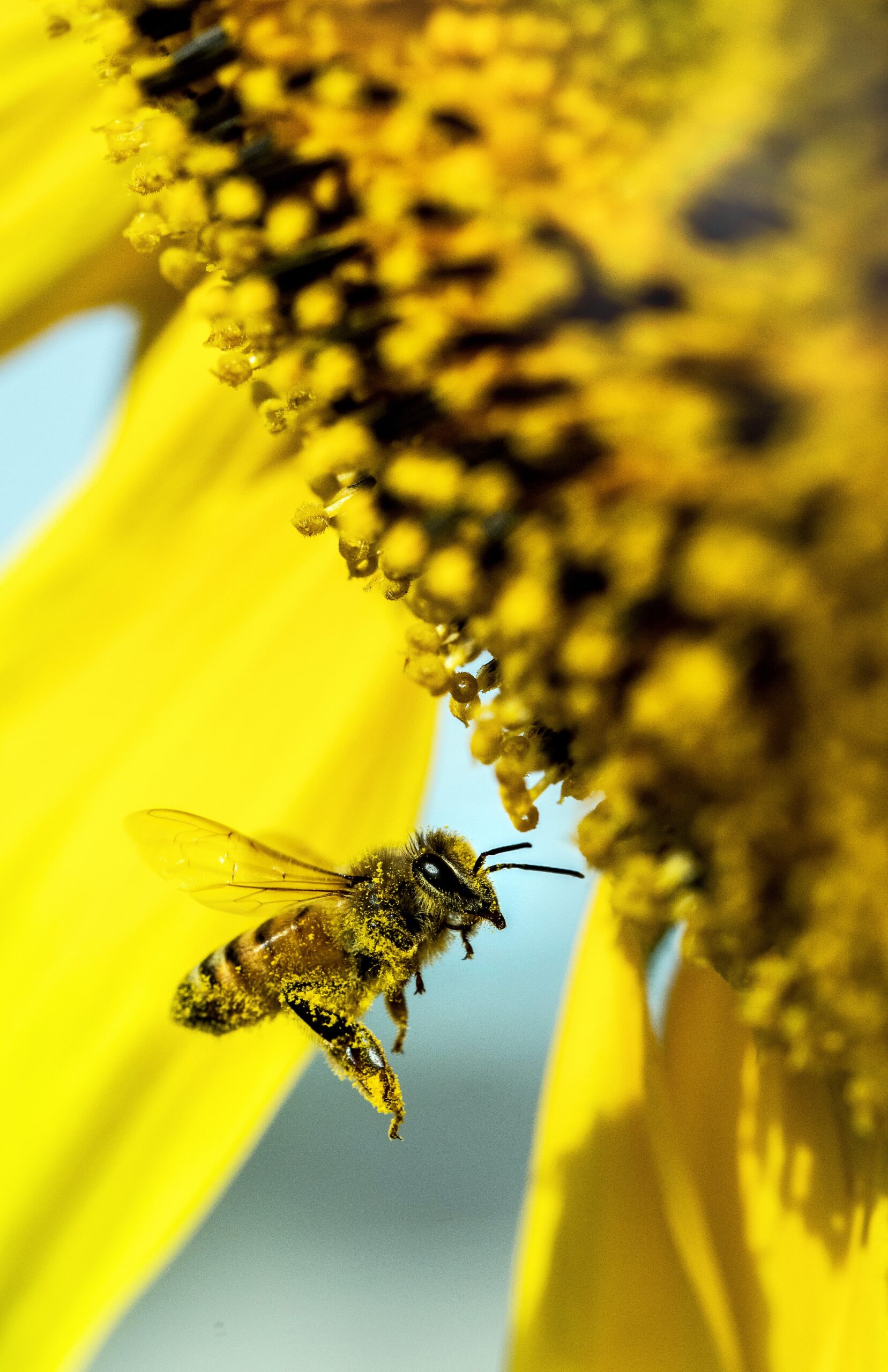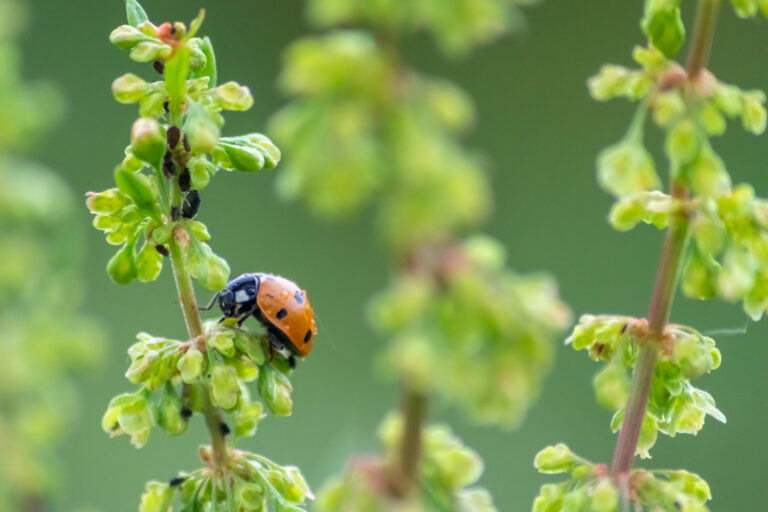Bug Off! How to Use Beneficial Insects in Your Garden
If only we could just drop some seeds into dirt, and water them lovingly every few days, life would be a breeze and I wouldn’t need to write these blog posts. Unfortunately, when we plant our tasty gardens, we’re inviting in a smorgasbord of harmful insects to snack on all of our hard work.
Now, you’re on a website about all natural gardening, so I’m obviously not going to recommend that you blast the bugs with nasty chemicals until they die. So what’s the other option? Well, sometimes it takes a bug to fight a bug! Yes, we are going to recruit a small army of beneficial insects to help us combat our pest problem.
These insects can help keep harmful pests at bay while also pollinating plants and contributing to the overall health of your garden.
Using beneficial insects is an eco-friendly and natural way to control pests in your garden. It’s a great alternative to using harmful chemicals that can harm the environment and potentially harm humans and animals. By introducing these friendly bugs into your garden, you can create a balanced ecosystem where pests are kept in check and plants thrive. Some common beneficial insects include ladybugs, lacewings, and praying mantises, all of which can help control pests like aphids, mites, and caterpillars.
In addition to their pest control benefits, beneficial insects can also contribute to the overall health of your garden. Many of these insects are pollinators, which means they help transfer pollen from one plant to another, leading to better fruit and vegetable production. These guys really work overtime to help your garden thrive!
Meet the Bug Buddies
Ladybugs: The Aphid Assassins
Ladybugs, also known as ladybirds, are a gardener’s best friend. These cute little beetles love to feast on aphids, mites, and other soft-bodied insects that can damage your plants. Ladybugs are easy to attract to your garden. Simply plant some flowers like daisies, marigolds, and yarrow, and they’ll come running.
Praying Mantises: The Predatory Priests
Praying mantises are the ultimate garden predators. These insects are known for their unique hunting style, where they patiently wait for their prey to come to them. They’ll eat anything from flies to caterpillars to other praying mantises. If you want to attract these beneficial insects to your garden, try planting some herbs like fennel, dill, and parsley.
Lacewings: The Aphid Lions
Lacewings, also known as aphid lions, are another beneficial insect that can help keep your garden pest-free. These insects are voracious predators that love to eat aphids, mites, and other small insects. Lacewings can be attracted to your garden by planting flowers like dandelions, cosmos, and sunflowers.
Overall, these bug buddies can be a great addition to any garden. They’re natural predators that can help keep your plants healthy without the use of harmful pesticides. Plus, they’re fun to watch! So, why not invite these beneficial insects to your garden today?
Recruiting Your Insect Army

Here are some tips for attracting and housing your new insect friends.
Flower Power: Attracting Beneficial Insects
One of the easiest ways to attract beneficial insects is by planting flowers. Not only do they provide nectar and pollen for bees and butterflies, but they also attract other beneficial insects like ladybugs, lacewings, and hoverflies. Here are some flowers to consider:
- Sunflowers: These sunny giants attract bees and butterflies with their large, pollen-rich flowers.
- Marigolds: These bright flowers repel pests like aphids and attract beneficial insects like ladybugs.
- Lavender: This fragrant herb attracts bees, butterflies, and hoverflies.
Habitat Hacks: Building Bug Condos
In addition to flowers, you can also provide habitat for beneficial insects by building bug condos. These are simple structures made out of natural materials like wood, bamboo, and straw. Here are some tips for building bug condos:
- Mason bee houses: Mason bees are excellent pollinators and will happily nest in small holes drilled into wood blocks or logs.
- Ladybug houses: Ladybugs will hibernate in small crevices during the winter, so providing a cozy house made out of straw or leaves can help attract them to your garden.
- Butterfly houses: Butterflies will roost in small spaces like those provided by a butterfly house. These can be made out of wood and decorated with bright colors to attract them.
With a little effort, you can turn your garden into a haven for beneficial insects. Not only will they help keep your garden healthy, but they’ll also add some life and color to your outdoor space.
You can also buy bugs. I swear. Somewhere out there, are people who have had the genius idea to breed beneficial bugs, and sell them. Check online, or at your local garden center.
The Art of Bug Warfare

Know Your Allies
Before you send your troops into battle, it’s important to know who you’re working with. Here are a few of the most common beneficial insects and what they can do for your garden:
- Ladybugs: These cute little bugs are actually fierce predators, feasting on aphids, mites, and other soft-bodied pests.
- Praying Mantises: These stealthy hunters will take down just about anything that crosses their path, from flies to grasshoppers.
- Lacewings: These delicate insects may look harmless, but their larvae are voracious predators that will devour aphids, mealybugs, and other pests.
- Parasitic Wasps: Don’t let the name fool you, these wasps are actually your friends. They lay their eggs inside pest insects, which then hatch and eat their way out. Gross, but effective.
Tactical Releases: Timing is Everything
Now that you know your allies, it’s time to put them to work. But before you release them into your garden, there are a few things to keep in mind. First, you’ll want to make sure you’re releasing them at the right time. For example, if you release ladybugs too early in the season, they may not have enough food to sustain them. Wait until you start to see aphids or other soft-bodied pests before releasing them.
You’ll also want to release your beneficial insects strategically. For example, if you have a bad infestation of aphids on your roses, release your ladybugs directly onto the affected plants. And don’t forget to provide habitat for your allies, such as planting flowers that attract lacewings and other helpful bugs.
In conclusion, the art of bug warfare is all about knowing your allies and using them strategically. With a little bit of planning and a lot of patience, you can keep your garden healthy and pest-free without resorting to harmful chemicals.
Avoiding Friendly Fire
In the war against garden pests, beneficial insects are valuable allies. However, it’s important to avoid “friendly fire” by inadvertently harming these good bugs. Here are a few tips to keep in mind:
Chemical Warfare: Pesticides and Collateral Damage
Pesticides may kill off the pests, but they can also harm beneficial insects. It’s important to use pesticides sparingly and only when necessary. When using pesticides, it’s important to read the labels carefully and follow the instructions. Some pesticides are toxic to bees, ladybugs, and other beneficial insects.
To avoid harming beneficial insects, consider using organic pesticides that are less toxic. For example, neem oil is an effective insecticide that won’t harm beneficial insects.
Companion Planting: Creating Alliances with Plants
Companion planting is a technique that involves planting certain plants together to create a mutually beneficial relationship. Some plants are natural pest repellents, while others attract beneficial insects.
For example, marigolds are known to repel aphids, whiteflies, and other pests. They also attract ladybugs, which feed on aphids and other garden pests. Planting marigolds around your garden can help keep pests at bay while attracting beneficial insects.
Another example is planting dill, fennel, or parsley. These plants are known to attract beneficial insects such as ladybugs and lacewings. They also provide a food source for caterpillars, which will eventually turn into beneficial butterflies.
In conclusion, using beneficial insects in your garden is a great way to control pests without resorting to harmful chemicals. However, it’s important to avoid “friendly fire” by taking care not to harm these good bugs. By following these tips, you can create a garden that is both beautiful and beneficial to the environment.
Monitoring and Maintenance

Bug Patrol: Regular Inspections
Keeping an eye on your garden is crucial when using beneficial insects. Regular inspections allow you to identify pest problems early and release the appropriate beneficials to combat them. A magnifying glass can be helpful in spotting small insects like aphids and mites.
It’s also important to be aware of the weather conditions in your area. High temperatures and drought can stress your plants and make them more susceptible to pests. In these conditions, it’s especially important to monitor your garden closely.
Feeding Your Troops: Keeping Beneficials Happy
Just like any other living organism, beneficial insects need food and water to survive. Providing them with a source of food and water can help them thrive in your garden.
One way to feed your troops is by planting flowers that attract beneficial insects. Examples include dill, fennel, and marigolds. These flowers provide nectar and pollen, which are important food sources for many beneficials.
Another way to keep your beneficials happy is by providing them with a source of water. A shallow dish filled with water and pebbles can provide a place for beneficials to drink without drowning.
By regularly monitoring your garden and providing food and water for your beneficials, you can create a healthy and thriving ecosystem that will help keep pests under control.
Troubleshooting Tips

When Good Bugs Go Bad
It’s a sad day when the good bugs turn bad. Ladybugs, lacewings, and other beneficial insects can become pests themselves if their populations get too high. Ladybugs, for example, can start eating your plants if there aren’t enough aphids around to feed them.
If you notice that your beneficial insects are causing more harm than good, it’s time to take action. Here are a few tips to help you get your garden back on track:
- Remove any excess food sources. If your ladybugs are eating your plants, it’s probably because there aren’t enough aphids around. Try removing any excess food sources to encourage the ladybugs to move on.
- Introduce natural predators. If you’re dealing with an overpopulation of ladybugs or other beneficial insects, consider introducing natural predators like birds or praying mantises to help keep their numbers in check.
- Use insecticidal soap. Insecticidal soap can be an effective way to control populations of beneficial insects without harming your plants. Just be sure to follow the instructions carefully and use it sparingly.
Reinforcements: When to Call for Backup
Sometimes, even the best-laid plans can go awry. If your garden is being overrun by pests, it’s time to call in the reinforcements. Here are a few signs that it’s time to bring in the cavalry:
- You’ve tried everything. If you’ve tried all the usual methods for controlling pests and nothing seems to be working, it’s time to call in the professionals.
- You’re dealing with a serious infestation. If your garden is being overrun by pests, it’s time to take action. Call in a professional pest control company to help you get the problem under control.
- You’re not sure what to do. If you’re not sure how to deal with a pest problem, it’s always best to seek professional advice. A pest control expert can help you identify the problem and come up with a plan of action.
Celebrating Your Victories
Garden Party: Hosting a Bug Banquet
What better way to celebrate the hard work of your beneficial insects than with a garden party? Set up a table with some of their favorite treats, such as fresh flowers, ripe fruit, and sugar water. Invite your friends and family to come and see the amazing work your insect army has done in your garden.
Make sure to have some bug-themed decorations, like paper butterflies or ladybug balloons, to set the mood. And don’t forget to thank your little helpers for all their hard work. After all, they’re the ones who made your garden thrive!
Success Stories: Sharing Your Triumphs
When your garden is looking better than ever thanks to your beneficial insects, it’s time to share your success stories. Talk to your neighbors, post on social media, or even enter your garden in a local competition.
Be sure to highlight the different types of insects you’ve used and the benefits they’ve brought to your garden. And don’t be afraid to show off your before-and-after pictures. Your success can inspire others to start using beneficial insects in their own gardens.
Remember, celebrating your victories is an important part of gardening. It’s a chance to recognize the hard work of your beneficial insects and to share your success with others. So go ahead, throw a bug banquet and share your triumphs with the world!






